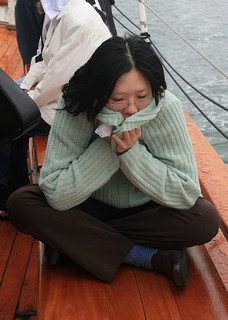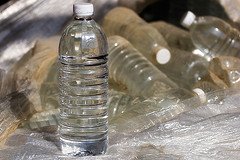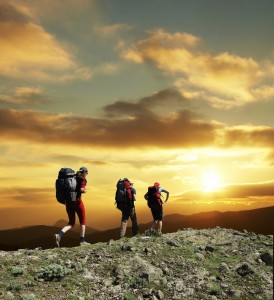Last month, we talked about infectious travel diseases and how to minimize your risk of getting them. Luckily your chances of catching a disease on a trip are quite slim, but travel illnesses can crop up when you least expect them. Whether you’re traveling close to home or taking a long-haul flight across the globe, here are some common travel illnesses you could encounter along the way as well as advice to keep them from ruining your trip.
Motion Sickness
 What is it? Motion sickness, also commonly known as “seasickness” or “airsickness” occurs when the eyes see motion, but the body does not sense it. This leads to a conflict between the senses resulting in nausea, vomiting, headache, and sweating.
What is it? Motion sickness, also commonly known as “seasickness” or “airsickness” occurs when the eyes see motion, but the body does not sense it. This leads to a conflict between the senses resulting in nausea, vomiting, headache, and sweating.
How to prevent it: If you’ve ever experienced motion sickness, you know that it’s beneficial to prevent it, because symptoms are hard to stop once they’ve started. If you’re flying, sit near the wings of the plane (SeatGuru helps you find the best seat by listing color-coded seating charts for hundreds of aircrafts). Cruisers should opt for an outside cabin in the middle of the ship–the natural balance point.
And while it’s tempting to play Angry Birds on your smartphone, looking down at a small screen while moving only exacerbates symptoms. Keep an eye on the horizon and opt for a bland, light meal before traveling—spicy, greasy foods can add to stomach discomfort that sometimes accompanies motion sickness. Antihistamines taken 30 minutes to an hour before a trip may help—popular medications include Bonine and Dramamine. Some travelers also swear by more holistic remedies like ginger chews, capsules or tea, which can help quell altitude-induced nausea.
Traveler’s Diarrhea (TD):
What is it? TD is a stomach and intestinal infection that occurs as a result of unsanitary handling of food, with the most common offender being bacteria called E coli. We probably don’t need to go into the specifics around the symptoms of TD, but anyone who’s had it knows it’s not a fun experience and can last up to 7 days. According to the CDC, Travelers’ diarrhea (TD) is the most common illness affecting travelers—each year between 20%-50% of international travelers, an estimated 10 million people, develop it. Higher-risk destinations for TD include the developing countries of Latin America, Africa, the Middle East and Asia.
 How to prevent it: First and foremost, avoid eating raw or under-cooked meat and seafood. If local water supplies are not safe to drink, use bottled water for drinking and brushing your teeth. When that’s not available, boiling tap water generally kills most micro-organisms, and there are a number of good water filters and purification tablets that can easily be stored in your carry-on. Fruits and vegetables washed in local water can also be unsafe to eat–if you can’t peel it or it hasn’t been thoroughly cooked, politely decline. Street food can be perfectly safe, but watch to see that it’s being cooked well and choose vendors who regularly attract a large crowd.
How to prevent it: First and foremost, avoid eating raw or under-cooked meat and seafood. If local water supplies are not safe to drink, use bottled water for drinking and brushing your teeth. When that’s not available, boiling tap water generally kills most micro-organisms, and there are a number of good water filters and purification tablets that can easily be stored in your carry-on. Fruits and vegetables washed in local water can also be unsafe to eat–if you can’t peel it or it hasn’t been thoroughly cooked, politely decline. Street food can be perfectly safe, but watch to see that it’s being cooked well and choose vendors who regularly attract a large crowd.
Altitude Sickness
 What is it? Long story short, the higher you go, the “thinner” the air gets—when you go too high too fast, your body cannot get the oxygen it needs. Symptoms of altitude sickness include headaches, dizziness, loss of appetite, nausea/vomiting, fatigue/loss of energy and insomnia. While many people can reach up to 8,000 feet without any ill effects, anyone who travels from lower altitudes to above 6,500 feet could experience altitude sickness.
What is it? Long story short, the higher you go, the “thinner” the air gets—when you go too high too fast, your body cannot get the oxygen it needs. Symptoms of altitude sickness include headaches, dizziness, loss of appetite, nausea/vomiting, fatigue/loss of energy and insomnia. While many people can reach up to 8,000 feet without any ill effects, anyone who travels from lower altitudes to above 6,500 feet could experience altitude sickness.
How to prevent it: Many people plan trips to high altitude destinations and don’t even know it. An easy way to check the elevation of your destination is to use a site like veloroutes.org. If you decide you could be at risk for altitude sickness, your doctor may prescribe a medication called acetazolamide, or simply advise you to pack ibuprofen, ginger chews, capsules or tea. Getting acclimated slowly can also help—for example, at the beginning of your trip, consider spending a night or two at an “intermediate” altitude before going higher. It’s also best to take it easy for the first 24-48 hours of your trip and plan more mellow activities that don’t involve a lot of physical exertion. Additional precautions include eating plenty of complex carbohydrates (whole grains, fruits, vegetables and legumes) and avoiding caffeine and alcohol as these can have diuretic (dehydrating) effects. You can learn even more about altitude sickness and prevention here.
Sun Poisoning
 What is it? Sun poisoning is a severe burn usually from ultraviolet (UV) radiation that inflames your skin. You’ll know your sunburn is more severe than your common sunburn when you experience the following symptoms: skin redness/blistering, pain/tingling, swelling, headache, fever/chills, nausea, dizziness and dehydration.
What is it? Sun poisoning is a severe burn usually from ultraviolet (UV) radiation that inflames your skin. You’ll know your sunburn is more severe than your common sunburn when you experience the following symptoms: skin redness/blistering, pain/tingling, swelling, headache, fever/chills, nausea, dizziness and dehydration.
How to prevent it: Following basic sun-safety tips is the best way to prevent sun poisoning. Choose waterproof sunscreens SPF 30 or higher, with broad-spectrum or multi-spectrum protection for both UVB and UVA rays. Look for a sunscreen that contains at least one of the following: ecamsule, avobenzone, oxybenzone, titanium dioxide, sulisobenzone, or zinc oxide.
Application tips: apply two ounces of sunscreen (about a handful) to dry skin thirty minutes before exposure to the sun which allows time for it to absorb properly. Re-apply every two hours or immediately after swimming or activities that make you sweat. Sunscreen should always be applied prior to insect repellant. Also, if you’re taking any medications, make sure to ask your doctor and/or pharmacist if anything you’re on could make your skin more sensitive to sunlight.
Of course anything can happen when we travel, no matter how many precautions we take. That’s why travel assistance is so important—if you get sick while you’re away, you’ll get assistance locating a qualified physician, hospital or pharmacy. If you need a prescription, there’s replacement assistance too. In the event of a serious illness or injury, you’ll receive emergency medical evacuation, which includes the planning and cost of transporting you home to your preferred doctor.
Safe Travels!
Photo Credits
Seasick by LiteTouch Photography
Bottled Water by Todd Morris


